Abstract
The Dual Smart Drive is a specially designed nonlinear actuator intended for use in climbing and walking legged robots. It features a continuously changing transmission ratio and dual properties and is very suitable for situations where the same drive is required to perform two different types of start-stop motions of a mobile link. Then, the associated control problem to this nonlinear actuator is established and a backstepping design strategy adopted to develop Lyapunov-based nonlinear controllers that ensure asymptotic tracking of the desired laws of motion, which have been properly selected using time-optimal control. The approach is extended for bounded control inputs. Both simulation and experimental results are presented to show the effectiveness and feasibility of the proposed nonlinear control methods for the Dual Smart Drive.
Similar content being viewed by others
References
Akinfiev, T. 1990. Method of controlling mechanical resonance hand. Pergamon, US Patent Number: 4958113.
Akinfiev, T. and Armada, M. 1998. Resonance and quasi-resonance drive for start-stop regime. Pergamon. In Proc. 6th International Conference MECHATRONICS' 98, Skovde, Sweden, pp. 91–96.
Akinfiev, T., Armada, M., Fontaine, J.G., and Louboutin, J.P. 1999. Quasi-resonance drive with adaptive control for start-stop regime. In Proceedings of the Tenth World Congress on the Theory of Machines and Mechanisms, IFToMM, Oulu University Press, vol. 5, pp. 2049–2054.
Akinfiev, T. and Armada, M. 2000. Some ways of increasing of walking machine drives effectiveness. In Proceedings of the 3rd International Conference on Climbing and Walking Robots and the Support Technologies for Mobile Machines, Professional Engineering Publishing Limited London, UK, pp. 519–528.
Akinfiev, T., Armada, M., and Fernández, R. 2005. Drive for start-stop movements, especially in walking robots, and its control method. Spanish PatentNumber: 2195792.
Armada, M., Gonzalez de Santos, P., Jimenez, M.A., and Prieto, M. 2003. Application of CLAWAR Machines. The International Journal of Robotics Research, 22(3/4):251–264.
Athans, M. and Falb, P.L. 1966. Optimal Control, McGraw-Hill Book Company: New York.
Bruneau, O., Louboutin, J.P., and Fontaine, J.G. 2000. Optimal design of a leg-wheel hybrid robot actuated by a quasi-resonant system. In Proceedings of the 3rd International Conference on Climbing and Walking Robots and the Support Technologies for Mobile Machines, Professional Engineering Publishing Limited London, UK, pp. 551–558.
Budanov, V. 2001. Underactuated leg of the walking machine. In Proceedings of the 4th International Conference on Climbing and Walking Robots, Professional Engineering Publishing Limited London, UK, pp. 167–171.
Caballero, R., Akinfiev, T., Montes, H., and Armada, M. 2001. On the modelling of smart nonlinear actuator for walking robots. In Proceedings of the 4th International Conference on Climbing and Walking Robots, Professional Engineering Publishing Limited London, UK, pp. 17–38.
Chilikin, M. and Sandler, A. 1981. General Course of Electric Drives, Energoizdat, Moscow.
Fernández, R., Akinfiev, T., and Armada, M. 2003. Modelling and control of the dual smart drive. In Proceedings of MED'03-11th Mediterranean Conference on Control and Automation, Rhodes, Greece.
Fernández, R., Akinfiev, T., and Armada, M. 2003. Dual smart drive: Analytical solution, simulation and experimental results. In Proceedings of the 6th International Conference on Climbing and Walking Robots and the Support Technologies for Mobile Machines, Professional Engineering Publishing Limited London, UK, pp. 309–318.
García, E. and González de Santos, P. 2001. Soft computing techniques for improving foot trajectories in walking machines. Journal of Robotic Systems, 18(7):251–264.
Ingvast, J. and Wikander, J. 2002. A passive load sensitive revolute transmission. In Proceedings of the 5th International Conference on Climbing and Walking Robots and the Support Technologies for Mobile Machines, Professional Engineering Publishing Limited London, UK, pp. 603–610.
Isidori, A. 1989. NonLinear Control Systems. Springer-Verlag: Berlin.
Kanellakopoulos, I., Kokotovic, P.V., and Morse, A.S. 1991. Systematic design of adaptive controllers for feedback linearizable systems. IEEE Trans. Automat. Contr., 36:1241–1253.
Khalil, H. K. 2002. Nonlinear Systems. Prentice Hall: New York.
Kokotovic, P. V. 1992. The Joy of feedback: Nonlinear and adaptive. IEEE Contr. Sys. Mag., 12:7–17.
Krstic, M., Kanellakopoulos, I., and Kokotovic, P.V. 1995. Nonlinear and Adaptive Control Design. Wiley: New York.
Lin, Y. and Sontag, E. 1991.A universal formula for stabilization with bounded controls. Systems & Control Lett., 16:393–397.
Pfeiffer, F., LÖfler, K. and Gienger, M. 2000. Design aspects of walking machines. In Proc. 3rd International Conference on Climbing and Walking Robots, Professional Engineering Publishing Limited London, UK, pp. 17–38.
Meckl, P.H. and Seering, W. 1985. Active damping in a three-axis robotic manipulator. A.S.M.E. Journal of Vibration, Acoustic, Stress, and Reliability in Design, 107:38–46.
Montes, H., Pedraza, L., Armada, M., Akinfiev, T., and Caballero, R. 2004. Adding extra sensitivity to the SMART non-linear actuator using sensor fusion. Industrial Robot: An International Journal, 31:179–188.
Roca, J., Palacin, J., Bradineras, J., and Iglesias, J.M. 2002. Lightweight leg design for a static biped walking robot. In Proceedings of the 5th International Conference on Climbing and Walking Robots and the Support Technologies for Mobile Machines, Professional Engineering Publishing Limited London, UK, pp. 383–390.
Sardin, P., Rostami, M., and Besonet, G. 1998. An anthropomorphic biped robot: Dynamic concepts and technological design. IEEE Transactions on Systems, Man and Cybernetics. Part A, Vol. 28.
Song, F. and Smith, S.M. 2000. Design of sliding mode fuzzy controllers for an autonomous underwater vehicle without system model. Oceans'2000 MTS/IEEE, pp. 835–840.
Van De Straete, H. and De Schutter, J. 1999. Optimal time varying transmission for servo motor drives. In Proceedings of the Tenth World Congress on the Theory of Machines and Mechanisms, IFToMM, Oulu University Press, 5:2055–2062.
Walking Machine Catalogue. http://gate1.fzi.deids/public_html/index2.htm.
Author information
Authors and Affiliations
Additional information
Supported by the Spanish Ministry of Education under Grant F.P.U.
Supported by the National Science Foundation under Grant No. ECS-0242798
Supported by the Spanish Ministry of Science and Technology under Grant Ramón y Cajal, Project “Theory of optimal Dual Drives for Automation and Robotics”
Roemi E. Fernández was born in Madrid, Spain, in 1977. She received the B.S. degree in Electronic Engineering from Santa Maria La Antigua University, Panamá, in 2000. She is currentlya PhD candidate at the Polytechnic University of Madrid, Spain and at the Industrial Automation Institute, which belongs to the Spanish Council for Scientific Research. Her research interests include nonlinear control theory, walking and climbing robots, resonance and quasi-resonance drives, and mechatronics.
Joáo P. Hespanha was born in Coimbra, Portugal, in 1968. He received the Licenciatura and the M.S. degree in electrical and computer engineering from Instituto Superior Técnico, Lisbon, Portugal, in 1991 and 1993, respectively, and the M.S. and Ph.D. degrees in electrical engineering and applied science from Yale University, New Haven, Connecticut, in 1994 and 1998, respectively. For his PhD work, Dr. Hespanha received Yale University's Henry Prentiss Becton Graduate Prize for exceptional achievement in research in Engineering and Applied Science.
Dr. Hespanha currently holds an Associate Professor position with the Department of Electrical and Computer Engineer at the University of California, Santa Barbara. From 1999 to 2001 he was an Assistant Professor at the University of Southern California, Los Angeles. His research interests include switching and hybrid systems; nonlinear control, both robust and adaptive; control of communication networks; the use of vision in feedback control; and stochastic games.
Dr. Hespanha is the recipient of an NSF CAREER Award (2001) and the 2002–2004 Automatica Theory/Methodology best paper prize. Since 2003, he has been an Associate Editor of the IEEE Transactions on Automatic Control.
Teodor Akinfiev received his M.S. degree from the Moscow State University and PhD degree from Mechanical Engineering Research Institute of the Academy of Sciences of Russia. From Year 1976 he was Researcher, Principal Researcher and Head of the Research Laboratory at the Mechanical Engineering Research Institute of the Academy of Sciences of Russia. From Year 1995 he holds Position at the Industrial Automation Institute, which belongs to the Spanish Council for Scientific Research. Teodor Akinfiev is the author over 200 publications (including more than 70 patents). His research interests include oscillation theory, mechanical engineering, control systems, robotics, intelligent drives, and mechatronics. In Year 2002 he was elected a Member of the Academy of Natural Sciences of Russia for his research cycle on resonance and quasi-resonance drives.
Manuel A. Armada received his PhD in Physics from the University of Valladolid (Spain) in 1979. Since 1976 he has been involved in research activities related to Automatic Control and Robotics. He has been working in more than forty RTD projects (European ones: EUREKA, ESPRIT, BRITE/EURAM, GROWTH, with Latin America: CYTED). He is member of the Russian Academy of Natural Sciences. Dr. Armada owns several patents and has published over 200 papers. He is currently the Head of the Automatic Control Department at the Instituto de Automatica Industrial (IAI-CSIC), being his main research in walking and climbing robots.
Rights and permissions
About this article
Cite this article
Fernández, R., Hespanha, J., Akinfiev, T. et al. Nonlinear Control for the Dual Smart Drive Using Backstepping and a Time-Optimal Reference. Auton Robot 19, 233–255 (2005). https://doi.org/10.1007/s10514-005-4044-0
Issue Date:
DOI: https://doi.org/10.1007/s10514-005-4044-0




